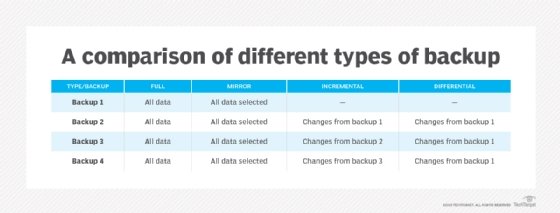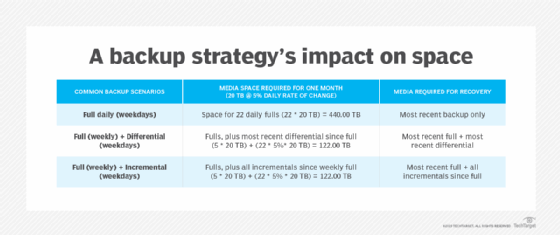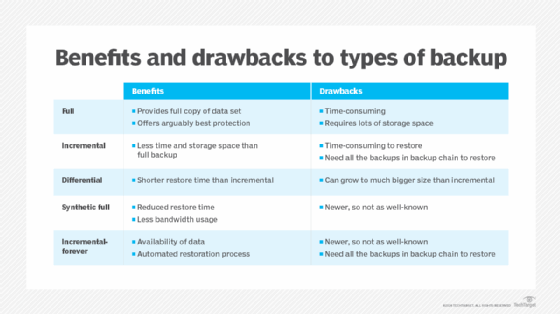Which of the Following Is a Type of Backup You Can Only Perform at Your Large Enterprise?
Protecting information against loss, corruption, disasters (human-acquired or natural) and other problems is one of the height priorities for Information technology organizations. In concept, the ideas are simple, although implementing an efficient andeffective prepare of fill-in operations can be difficult.
The term backup has get synonymous with data protection over the past several decades and may exist achieved via several methods. Backup software applications reduce the complexity of performing backup and recovery operations. Backing upwards data is but 1 part of a disaster protection program, and may not provide the level of information and disaster recovery capabilities desired without careful pattern and testing.
Backup applications accept long offered several types of fill-in operations. The most common backup types are a full fill-in, incremental backup and differential backup. Other backup types include synthetic total backups and mirroring.
In the debate over deject vs. local fill-in, there are some types of backup that are amend in certain locations. If y'all're performing cloud fill-in, incremental backups are by and large a meliorate fit because they swallow fewer resources. You might start out with a total backup in the cloud and then shift to incremental backups. Mirror backup, though, is typically more of an on-premises approach and oftentimes involves disks.
1. Full backups
The nearly basic and complete type of backup operation is a full fill-in. As the name implies, this type of backup makes a copy of all information to a storage device, such as a deejay or record. The primary advantage to performing a total backup during every operation is that a complete copy of all data is bachelor with a unmarried gear up of media. This results in a minimal time to restore information, a metric known as arecovery time objective. However, the disadvantages are that it takes longer to perform a total backup than other types (sometimes past a factor of 10 or more than), and it requires more storage space.
Thus, total backups are typically run only periodically. Data centers that take a modest amount of information (or critical applications) may choose to run a total backup daily, or even more than frequently in some cases. Typically, backup operations employ a full fill-in in combination with either incremental or differential backups.
2. Incremental backups
An incremental backup operation will result in copying only the data that has changed since the final backup functioning of any blazon. An organization typically uses the modified time stamp on files and compares it to the time postage of the concluding backup. Backup applications track and record the engagement and time that backup operations occur in order to track files modified since these operations.
Because an incremental backup will simply copy information since the last fill-in of any type, an organization may run it as often as desired, with simply the most recent changes stored. The benefit of an incremental fill-in is that information technology copies a smaller amount of data than a full. Thus, these operations volition take a faster backup speed, and require less media to store the fill-in.
iii. Differential backups
A differential backup operation is similar to an incremental the first fourth dimension information technology is performed, in that information technology will copy all information inverse from the previous backup. However, each time information technology is run afterwards, it will continue to copy all information changed since the previous full fill-in. Thus, information technology will store more backed up information than an incremental on subsequent operations, although typically far less than a full fill-in. Moreover, differential backups require more space and time to complete than incremental backups, although less than full backups.

As shown in "A comparison of different types of backup," above, each backup process works differently. An organization must run a full backup at to the lowest degree one time. For subsequent backups, information technology is possible to run either another full, an incremental or a differential fill-in. The get-go partial backup performed, either a differential or incremental, volition back up the same data. Past the third backup operation, the data that is backed upward with an incremental is limited to the changes since the concluding incremental. In comparison, the third backup with a differential will support all changes since the first total backup, which was "Fill-in i."
From these three primary types of backup, it is possible to develop an approach for comprehensive data protection. An organization often uses one of the following backup settings:
- Total daily
- Full weekly + differential daily
- Full weekly + incremental daily
Many considerations will bear upon the choice of the optimal backup strategy. Typically, each alternative and strategy choice involves making tradeoffs between performance, data protection levels, full amount of information retained and cost. In "A backup strategy'due south bear upon on space" below, the media capacity requirements and media required for recovery are shown for three typical fill-in strategies. These calculations assume 20 TB of total information, with 5% of the data changing daily, and no increment in total storage during the period. The calculations are based on 22 working days in a month and a i-month memory flow for data.

As shown in a higher place, performing a full backup daily requires the most corporeality of infinite, and will likewise take the virtually amount of fourth dimension. Yet, more full copies of data are available, and fewer pieces of media are required to perform a restore operation. Equally a result, implementing this backup policy has a college tolerance to disasters, and provides the least time to restore, since any piece of data required will be located on at most one backup set.
As an alternative, performing a full backup weekly, coupled with running incremental backups daily, will deliver the shortest backup time during weekdays and apply the least corporeality of storage space. Yet, there are fewer copies of data available and restore time is the longest, since an arrangement may need to utilize vi sets of media to recover the necessary information. If information is needed from data backed upwardly on Wednesday, the Sunday full backup, plus the Monday, Tuesday and Wed incremental media sets, are required. This can dramatically increase recovery times, and requires that each media gear up piece of work properly; a failure in one fill-in set tin impact the entire restoration.
Running a weekly total backup plus daily differential backups delivers results in betwixt the other alternatives. Namely, more backup media sets are required to restore than with a daily full policy, although less than with a daily incremental policy. Too, the restore time is less than using daily incremental backups, and more daily total backups. In gild to restore data from a particular day, at nigh ii media sets are required, diminishing the time needed to recover and the potential for problems with an unreadable fill-in set.
4. Mirror backups
A mirror backup is comparable to a total backup. According to a blog from backup vendor Nakivo, "This backup type creates an verbal re-create of the source data ready, but just the latest data version is stored in the backup repository with no track of unlike versions of the files." The fill-in is a mirror of the source data, thus the name. All the different backed up files are stored separately, like they are in the source.
One of the benefits of mirror backup is a fast data recovery fourth dimension. It's also easy to admission individual backed up files.
Ane of the main drawbacks, though, is the amount of storage space required. With that extra storage, organizations should be wary of cost increases and maintenance needs. In improver, if there'southward a problem in the source information set, such every bit a abuse or deletion, the mirror fill-in experiences the same. Every bit a result, it's a good idea not to rely on mirror backups for all your data protection needs, and to accept other types of backup for the information. You lot'll want to follow the 3-2-ane rule of fill-in, which includes three copies of data on two different media, with one copy off site.
One specific kind of mirror, disk mirroring, is besides known every bit RAID 1. This procedure replicates data to two or more disks. Deejay mirroring is a stiff option for data that needs high availability because of its quick recovery fourth dimension. It's likewise helpful for disaster recovery considering of its immediate failover adequacy. Disk mirroring requires at to the lowest degree two physical drives. If i hard drive fails, an organization tin can use the mirror copy. While disk mirroring offers comprehensive data protection, it requires a lot of storage chapters.
Do the correct matter for your organization
For organizations with small data sets, running a daily full fill-in provides a high level of protection without much additional storage space costs. Larger organizations or those with more data or server volume detect that running a weekly full backup, coupled with either daily incremental backups or differential backups, provides a ameliorate option. Using differentials provides a college level of information protection with less restore time for well-nigh scenarios and a small increase in storage capacity. For this reason, using a strategy of weekly total backups with daily differential backups is a good choice for many organizations.

About of the advanced types of backup such as synthetic full, mirror and continuous data protection require disk storage as the fill-in target. A constructed full only reconstructs the full backup paradigm using all required incremental backups or the differential backup on disk. This synthetic full may then be stored to tape for offsite storage, with the advantage being reduced restoration fourth dimension. Finally, continuous data protection enables a greater number of restoration points than traditional fill-in options.
When deciding which type of backup strategy to utilise, the question is when to use each, and how these options should be combined with testing to meet the overall concern cost, operation and availability goals.
The purpose of nigh backups is to create a copy of data then that a item file or application may exist restored after data loss, corruption or deletion, or a disaster strikes. Thus, backup is non the goal, only rather it is one means to accomplish the goal of protecting data. Testing backups is just as important equally data backup and restore. Again, the point of data fill-in is to enable restoration of information at a later point in time. Without periodic testing, information technology is impossible to guarantee that the goal of protecting data is existence met.
Dig Deeper on Disk-based backup
-

Full vs. incremental vs. differential: Comparing backup types
-

Full Backup
-

Differential Fill-in
-

Incremental Backup
Source: https://www.techtarget.com/searchdatabackup/feature/Full-incremental-or-differential-How-to-choose-the-correct-backup-type



0 Response to "Which of the Following Is a Type of Backup You Can Only Perform at Your Large Enterprise?"
Post a Comment